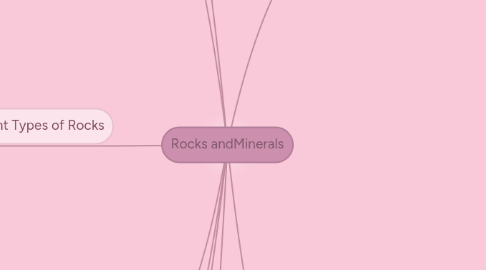
1. People that study Rocks and Minerals
1.1. Geologists
2. Items that are in Rocks
2.1. minerals
3. Things that minerals can help
3.1. Plants
4. Are found in rocks
5. Different Types of Rocks
5.1. Metamorphic
5.1.1. Examples
5.1.1.1. Marble
5.1.1.2. Phyllite
5.1.2. How they are formed
5.1.2.1. Heat and Pressure
5.2. Igneous
5.2.1. Examples
5.2.1.1. Kimberlite
5.2.1.2. Obsidian
5.2.2. How they are formed
5.2.2.1. From cooling of magma
5.3. Sedimentary
5.3.1. Examples
5.3.1.1. Chert
5.3.1.2. Coal
5.3.2. They can contain fossils
5.3.3. How they are formed
5.3.3.1. Fossils are often formed during the gradual layering of sediments
6. Rocks
6.1. Layers
6.1.1. Magma
6.1.1.1. Volcanoes have this layer
6.1.2. Intrusive Igneous rock
6.1.3. Extrusive Igneous rok
6.1.4. Soil
6.1.5. Sediements
6.1.6. Sedimentary rock
6.1.7. metamorphic rock
6.1.7.1. Pressure and increased temperature can create this layer
7. Definition: A solid inorganic substance of natural occurrence
8. can be identified with their
8.1. Properties
8.1.1. Hardness
8.1.1.1. Moh's Hardness Scale 10 Being the hardest 1 being the softest
8.1.1.1.1. 10: Diamond
8.1.1.1.2. 9: Corundum
8.1.1.1.3. 8: Topaz
8.1.1.1.4. 7: Quarts, Steel
8.1.1.1.5. 6: Orthoclase
8.1.1.1.6. 5 1/2: Glass
8.1.1.1.7. 5: Aptite
8.1.1.1.8. 4 1/4: Platinum
8.1.1.1.9. 4: Fluorite
8.1.1.1.10. 3: Calcite
8.1.1.1.11. 2 3/4: Native Copper
8.1.1.1.12. 2 2/3: Silver
8.1.1.1.13. 2 1/2: Fingernail
8.1.1.1.14. 2: Gypsum
8.1.1.1.15. 1: Talk, Graphite (pencil lead)
8.1.2. Color
8.1.3. Transparency
8.1.3.1. Transparent
8.1.3.1.1. Light can travel through it
8.1.3.2. Translucent
8.1.3.2.1. If light sort of travels through it
8.1.3.3. Opaque
8.1.3.3.1. If light can't travel through it
8.1.4. Luster
8.1.4.1. Glassy
8.1.4.2. Brilliant
8.1.4.3. Dull
8.1.5. Crystal shape
8.1.5.1. Octahedron
8.1.5.2. Cube
8.1.5.3. Tetrahedron
8.1.5.4. Rhombohedron
8.1.6. Size (longest edge)
8.1.7. Reaction with acid
8.1.7.1. If you used HCl acid on a rock and it bubble or fizzed then it had a reaction with acid but if doesn't do that then i doesn't have a reaction with acid
8.1.8. Light refraction
8.1.8.1. If th
